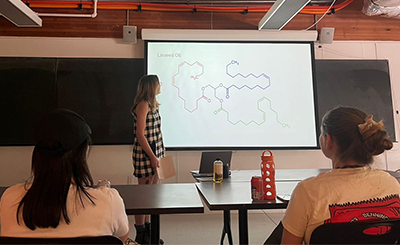Where Art and Science Combine: Eve Vishnick ’23
Eve Vishnick ’23 has always been torn between studying visual arts and more science-related fields. She was attracted to Bennington for two reasons, she said. “Great financial aid and the ability to combine two separate fields without having to double major. I could make it into one thing. That was a big draw for me.”
 The interdisciplinary nature of the Bennington curriculum allowed her to divide her time equally between art history and chemistry.
The interdisciplinary nature of the Bennington curriculum allowed her to divide her time equally between art history and chemistry.
She is particularly grateful to have traveled to Italy with Art History Professor Dr. J. Vanessa Lyon and for her Field Work Terms, which have taken her into archives around the Northeast to gain experience with what has become her passion: art conservation.
“That’s where the two fields, art history and chemistry, combine,” she said.
During Field Work Term, Vishnick has worked at the International Women’s Air and Space Museum in Cleveland, OH; the Franklin Furnace Archive in Brooklyn, NY; and Dartmouth’s Book Conservation Lab in Hanover, NH.
“This past year, I was a fellow for the Creative Legacies Fellowship at the Al Held Foundation doing digital archive work.”
Vishnick began in her third year by taking tutorials with John Bullock. She used infrared spectroscopy to examine art materials, including pigments she had made and linseed oil, the main oil binder in oil paints. During a transition metal class, also with Bullock, she had a startling moment of realization.
“I put together the fact that there are these cobalt catalysts that are used in oil painting,” she said. “And I began looking at the curing of linseed oil in the presence of the cobalt catalysts using infrared.”
She discovered that the second in the four-step reaction is actually catalyzed.
“In all of the literature around it, nobody cites the fact that that step is catalyzed,” she notes. “From my data, it totally is.”
Vishnick looks forward to submitting to journals in hopes of publishing and to applying for graduate programs in art conservation.
"I think Bennington's interdisciplinary approach has really prepared me for any future graduate studies immensely. I've really been able to learn how to focus on multiple things at once and to make the most of classes in terms of adapting to what I'm interested in," Vishnick said. "On a more practical note, I think it's also prepared me in terms of writing especially.”
Learn more about studying science and visual arts at Bennington.